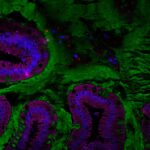Link to Pubmed [PMID] – 22789019
Link to DOI – 10.1111/j.1462-2920.2012.02824.x
Environ Microbiol 2013 Feb; 15(2): 355-71
Ileal lesions of patients with Crohn’s disease are colonized by adherent-invasive Escherichia coli (AIEC). The earliest lesions of recurrent Crohn’s disease are erosions of Peyer’s patches (PP). We recently reported the presence of a functional lpf operon in AIEC, encoding long polar fimbriae (LPF), that allows AIEC bacteria to interact with PP and to translocate across M cells. The aim of this study was to analyse the effect of gastrointestinal conditions on LPF expression in AIEC strains. The LF82 bacterial growth in an acid pH medium or at high osmolarity medium had no effect on lpf transcription level, in contrast to bacterial growth in the presence of bile salts, which promoted activation of lpf transcription. When cultured in the presence of bile salt, LF82 wild-type bacteria, but not the isogenic mutant deleted for lpfA, exhibited a higher level of interaction with PP and a higher level of translocation through M cell monolayers. The FhlA transcriptional factor was found to be a key bacterial regulator at the origin of LPF expression in the presence of bile salts.


